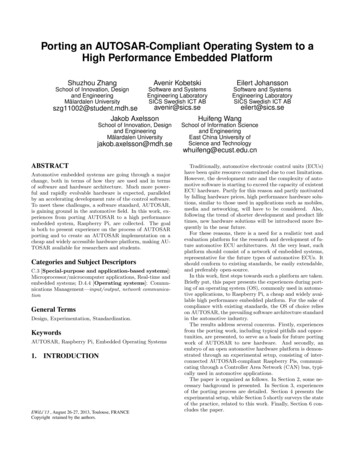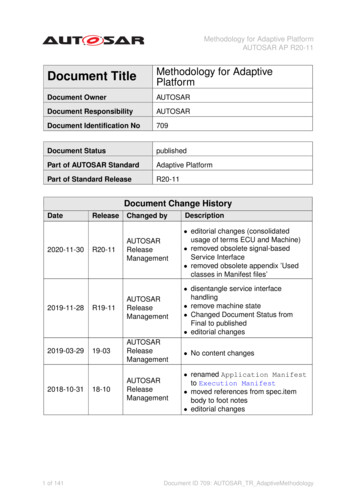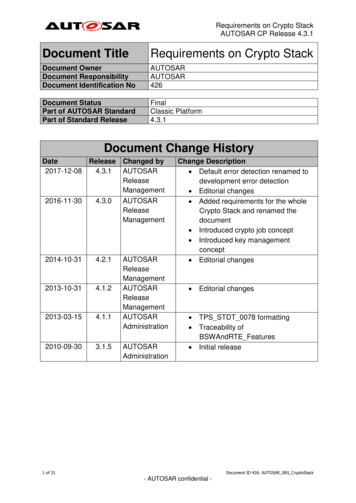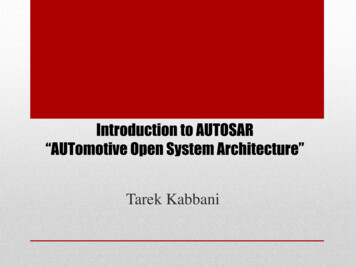
Transcription
Porting an AUTOSAR-Compliant Operating System to aHigh Performance Embedded PlatformShuzhou ZhangAvenir KobetskiEilert JohanssonSchool of Innovation, Designand EngineeringMälardalen UniversitySoftware and SystemsEngineering LaboratorySICS Swedish ICT ABSoftware and SystemsEngineering LaboratorySICS Swedish ICT .seJakob AxelssonHuifeng WangSchool of Innovation, Designand EngineeringMälardalen Universityjakob.axelsson@mdh.seABSTRACTAutomotive embedded systems are going through a majorchange, both in terms of how they are used and in termsof software and hardware architecture. Much more powerful and rapidly evolvable hardware is expected, paralleledby an accelerating development rate of the control software.To meet these challenges, a software standard, AUTOSAR,is gaining ground in the automotive field. In this work, experiences from porting AUTOSAR to a high performanceembedded system, Raspberry Pi, are collected. The goalis both to present experience on the process of AUTOSARporting and to create an AUTOSAR implementation on acheap and widely accessible hardware platform, making AUTOSAR available for researchers and students.Categories and Subject DescriptorsC.3 [Special-purpose and application-based systems]:Microprocessor/microcomputer applications, Real-time andembedded systems; D.4.4 [Operating systems]: Communications Management—input/output, network communicationGeneral TermsDesign, Experimentation, Standardization.KeywordsAUTOSAR, Raspberry Pi, Embedded Operating Systems1.INTRODUCTIONEWiLi’13 , August 26-27, 2013, Toulouse, FRANCECopyright retained by the authors.School of Information Scienceand EngineeringEast China University ofScience and Technologywhuifeng@ecust.edu.cnTraditionally, automotive electronic control units (ECUs)have been quite resource constrained due to cost limitations.However, the development rate and the complexity of automotive software is starting to exceed the capacity of existentECU hardware. Partly for this reason and partly motivatedby falling hardware prices, high performance hardware solutions, similar to those used in applications such as mobiles,media and networking, will have to be considered. Also,following the trend of shorter development and product lifetimes, new hardware solutions will be introduced more frequently in the near future.For these reasons, there is a need for a realistic test andevaluation platform for the research and development of future automotive ECU architectures. At the very least, suchplatform should consist of a network of embedded systems,representative for the future types of automotive ECUs. Itshould conform to existing standards, be easily extendable,and preferably open-source.In this work, first steps towards such a platform are taken.Briefly put, this paper presents the experiences during porting of an operating system (OS), commonly used in automotive applications, to Raspberry Pi, a cheap and widely available high performance embedded platform. For the sake ofcompliance with existing standards, the OS of choice relieson AUTOSAR, the prevailing software architecture standardin the automotive industry.The results address several concerns. Firstly, experiencesfrom the porting work, including typical pitfalls and opportunities, are presented, to serve as a basis for future portingwork of AUTOSAR to new hardware. And secondly, anembryo of an open automotive hardware platform is demonstrated through an experimental setup, consisting of interconnected AUTOSAR-compliant Raspberry Pis, communicating through a Controller Area Network (CAN) bus, typically used in automotive applications.The paper is organized as follows. In Section 2, some necessary background is presented. In Section 3, experiencesof the porting process are detailed. Section 4 presents theexperimental setup, while Section 5 shortly surveys the stateof the practice, related to this work. Finally, Section 6 concludes the paper.
2.BACKGROUNDIn this section, basic information related to the AUTOSARstandard and the specifics of the hardware architecture behind Raspberry Pi is presented.2.1AUTOSARFor the last decade, the automotive industry has been developing a software architecture standard, currently prevailing in this business segment, called the Automotive OpenSystem Architecture (AUTOSAR) [2, 11].AUTOSAR is a layered software architecture that decouples application software (ASW) from lower level basic software (BSW) by means of a standardized middleware calledruntime environment (RTE). This allows running the sameapplication software seamlessly on different hardware platforms, as long as the underlying hardware is linked with theRTE through appropriate BSW. The BSW consists of an operating system that has evolved from the OSEK standard;system services for e.g., memory management; communication concepts; ECU and microcontroller abstraction layers (ECUAL and µCAL respectively); and complex devicedrivers for direct access to hardware, see Figure 1.on-chip solution is robust and compact. The main disadvantage of this solution is again its simplicity, making it impossible to utilize the latest memory chip technologies dueto different CMOS manufacturing technologies for SDRAM,Flash and CPUs.In contrast, Raspberry Pis are based on microcontrollerswith external flash memories for code storage and executionfrom RAM, which makes them suitable for high performanceapplications, such as video streaming. This is an importantconsideration in future automotive applications since performance and memory constraints are expected to grow considerably in a near future, when vehicles start to cooperateexchanging information with each other and surrounding infrastructure, see e.g. [13]. Other advantages of RaspberryPis are their low cost and wide availability, which was thefinal rationale behind using them in our work.A Raspberry Pi has a Broadcom BCM2835 system on chip(SoC) [10], which includes an ARM1176JZF-S 700 MHz processor, VideoCore IV GPU, and 512 megabytes of RAM.The microcontroller has a standard RJ45 based Ethernetport and some external GPIOs for adding sensors and actuators as well as other peripherals through SPI, IIC orUART ports. The performance is expected to be severalmagnitudes higher than a traditional microcontroller basedautomotive ECU.On the downside, the Raspberry Pi architecture requiresmore complex and time consuming start up procedures, copying and in some cases unpacking of code from flash to RAM.The runtime environment may also give other considerationssuch as memory protection against software failure and increased risk of single event upsets. Cache memory, pipelining and multi-core will add complexity to the softwareand system design from a real-time perspective due to variations in execution time.3.Figure 1: AUTOSAR layer structureThere exist several implementations of the AUTOSARstandard. However, most of those are commercial productswhich often makes them unsuitable for research purposes. Inthis work, ArcticCore [1] – one of the very few open-sourceAUTOSAR implementations – was chosen. ArcticCore contains among other a real-time OS, memory management,and ECUAL software. For some hardware architectures,mostly those that are currently popular in the automotiveindustry, such as Freescale MPC5xxx, also the µCAL software is implemented.This work is based on AUTOSAR 3.2, with the focuson extending existing ArcticCore source code to make itrunnable on Raspberry Pis. First, the ArcticCore OS kernelneeds to be amended to allow the system to start up. Oncethis is done, the existing ECUAL code needs to be connectedto the underlying hardware in the µCAL layer through appropriate driver development. The details and experiencesof the porting work are further described in Section 3.2.2Raspberry PiTraditionally, automotive ECUs are equipped with microcontrollers that include flash memory and static RAM on thesame chip. Code is executed by direct readings, instructionby instruction, from the flash memory. The advantages arethat the ECU design becomes simple and that the memoryTHE PORTING PROCESSThis section discusses our experiences from the AUTOSARporting process on Raspberry Pi. The first part introducesthe four core steps that were taken to set up the AUTOSAROS kernel and prepare it for running on a Raspberry Pi.This kernel development process includes initialization, memory modelling, exception handling and context switch.Initialization is the first code that is executed when theoperating system starts up. Data structures, global variables, and hardware are set up in this stage in order toprepare necessary configuration for the operating system.Memory handling builds the system and task stacks so asto determine how much memory is available for either thetasks or the system. The method for handling interruptsand exceptions is a critical part of the architecture design ofthe operating system. Finally, a context switch is needed tohandle scheduled tasks.The second part focuses on the development process ofa Serial Peripheral Interface (SPI) driver according to AUTOSAR standard requirements. This is just an example toshow a general method for developing a hardware driver onRaspberry Pi that complies with the AUTOSAR standard.3.1Kernel development processA Raspberry Pi’s boot process starts with a small ROMbased primary boot loader copying a file containing a secondary boot loader from SDHC card into the L2 cache ofthe microcontroller. The secondary boot loader initializes
SDRAM and loads a third boot loader into SDRAM whichstarts up the operating system. The bootloader of Raspberry Pi can be obtained from the Raspberry official forum,including bootcode.bin, loader.bin and start.elf. It bootsARM from the 0x00008000 in the ARM address space, andthat is the ARM entry point and location for the first ARMinstruction that we can control.3.1.1InitializationNormally, there are three main stages of initializing anoperating system on ARM architecture – startup, executing process control block (PCB) setup code, and executingthe C initialization code [4]. During the startup stage, anexception vector table should be built. Table 1 shows sucha vector for the ARM architecture. The vector table contains the addresses that the ARM processor branches to ifan exception is raised.Program execution starts with a reset exception, whichtriggers the reset handler. In the reset handler, the exceptionvector table needs to be copied to the address 0x00000000,because initially it is at the address 0x00008000 due to theboot process of the Raspberry Pi. After that the Undefined,Abort, FIQ, SVC, IRQ and System base stack registers areset up. Once the stacks are set up, the processor is switchedback into the SVC mode, which allows the rest of the initialization process to continue.In the PCB setup stage, there are four major parts of thePCB that have to be initialized: the program counter, thelink register, the user mode stack, and the saved processorstatus register (which in the ARM case means registers r13,r14, r15, and spsr) for each task.A timer is an important part of a real-time OS, providinga system tick for OS. In the ArcticCore OS, the system tickis defined to 1 millisecond. Hence, a timer should be enabledin the C initialization stage. When the timer is activated,a counter will start to decrement the value, which in ourcase is 1000, in the specified timer register. Once the valuereaches zero, an interrupt is raised. In the timer interruptservice routine, the AUTOSAR OS will check the schedulertable and alarm to decide which task should be run next.3.1.2Memory ModelWe implemented a simple memory model for the AUTOSAR OS, as shown in the Figure 2. ARM physical addresses start at 0x00000000 for the RAM. An interrupt tableis built from 0x00000000 to 0x000000020. Then the codesection, heap and stack are arranged. A good stack designtries to avoid stack overflow because it may cause instabilityin embedded systems [4, 14]. Hence, we put the interruptstack at the top of the memory above the user stack. Inthis way the vector table will not be corrupted when a stackoverflow occurs, and so the system has a chance to correctitself when an overflow has been identified. The addressrange from 0x20000000 to 0x20FFFFFF is used for microcontroller registers. The hardware interfaces can then becontrolled by accessing corresponding address in this area.3.1.3Interrupts and Exceptions HandlingTwo types of exceptions were implemented in this porting work, the reset exception as mentioned before and theIRQ exception. In our case, a non nested interrupt handler structure was chosen since it is suitable for an initialporting stage when there are not many interrupt sources.Figure 2: System memory layoutWhen more sources are added, a nested interrupt handlerwill be needed to make execution of the AUTOSAR OS ona Raspberry Pi more efficient. This will be implemented ata later stage. Figure 3 describes the process about how anon-nested interrupt handler is implemented.Figure 3: Nonnested interrupt handlerWhen an interrupt occurs (e.g. timer interrupt or SPItransmit/receive interrupt), an IRQ exception is triggeredand the ARM processor disables further IRQ exceptionsfrom occurring. Upon entry to the interrupt handler, thehandler code saves the current context of non-banked registers. The handler then identifies the interrupt source according to the interrupt’s number and executes the appropriate interrupt service routine (ISR). For example, SPI ISRis called when an SPI transmit interrupt occurs. In AUTOSAR OS, all ISRs have already been registered in aninterrupt vector during the OS initialization stage, based onthe priority of source interrupts. Upon return from the ISR,the handler restores the context. Finally, interrupts are enabled again and the task which was interrupted can continueits execution.3.1.4Context SwitchWhen a new task has been scheduled for execution, thenew and old tasks have to be swapped with a context switch.To achieve this, the ARM context switch splits the activityinto two stages [5, 6]. In the first stage, the state of the current task must be saved somehow, so that, when the scheduler gets back to the execution of this task, it can restore itsstate and continue. The state of the current task includesall the registers that the task may be using, especially theprogram counter, together with any other OS specific datathat may be necessary. This data is usually stored in a datastructure called PCB. In the second stage, the registers withdata from the new task’s PCB should be loaded. In doing so,
ExceptionResetUndefined InstructionSoftware InterruptPrefetch AbortData AbortInterrupt RequestFast Interrupt RequestTable 1: ARM processor exception vectorModeMain purposeSVCInitializes the systemUND Software emullayeration of hardware coprocessorsSVCProtected mode for operating systemsAbortMemory protection handlingAbortMemory protection handlingIRQInterrupt request handlingFIQFast interrupt request handlingthe program counter from the PCB is loaded, and thus execution can continue in a new task. The new task is chosenfrom a task queue according to its priority.In the porting work, two types of context switch needed tobe implemented. One is the interrupt context switch thatwas already described in Section 3.1.3. And another oneis the task context switch, shown in Figure 4. A task isassumed to run in ARM mode and uses the SYS registers.Firstly, the context of the current task should be saved ontoits own stack. Secondly, the stack pointer of the old taskbeing switched out is saved into the the current task PCB.Thirdly, the stack pointer is loaded from the OS PCB of thenew task. Lastly, the context of the new task is pulled offthe stack. Then the microcontroller resumes the new 0C0x000000100x000000180x0000001CSelect wire (CS) and transmitted via a 3-wire interface consisting of serial data output (MOSI), serial data input (MISO),and a serial clock (CLOCK).The AUTOSAR standard defines a hierarchical structureof sequences, jobs and channels [7] to describe data transmission process on a SPI bus. A sequence contains one orseveral jobs, which are in turn composed of channels withthe same CS signal. A channel is the actual place holder forthe transmitted data.In Figure 5, an example of SPI communication, packagedin the AUTOSAR way, is shown. Transmission of a sequenceis initiated via an API call, such as Spi SyncTransmit. Thesequence consists of two jobs, job n and m. At first, jobn arbitrates the bus. After the data transfer of channel xis finished, the next channel of job n gets started withoutreleasing the bus. When the transmission of both channelsis finished, the bus is released by job n and job m starts totransmit data until the sequence a is finished.Figure 5: SPI transmission structure3.2.2Figure 4: Task context switch3.2Driver development processIn this subsection the process of developing µCAL software that follows existing AUTOSAR specifications is exemplified through the development of a Serial PeripheralInterface (SPI) driver. Firstly, some SPI related conceptsand terms used in the AUTOSAR standard are presented.Secondly, data structures and functions that are used forcommunication are described.3.2.1BackgroundThe SPI (Serial Peripheral Interface) is a 4-wire synchronousserial interface. Data communication is enabled by a ChipTypes definitionTo configure sequences, jobs and channels mentioned above,their supporting data structures should be implemented.Here, five data structures will be introduced based on somebasic types from the AUTOSAR standard definition.The Spi ConfigType is the main data structure that contains the others and includes configurations for channels,jobs, sequences, and external device structures (Spi ChannelConfig, Spi JobConfig, Spi SequenceConfig, and Spi ExternalDevice respectively). In this way, all the necessary information can be passed in one block to the Spi Init functionfor the initialization of the SPI handler/driver.The data stucture of Spi SequenceConfig should contain aflag used to specify whether this sequence can be interruptedby another sequence, a variable to specify the sequence’sname, and an array of pointers to jobs in this sequence.
The data structure of Spi JobConfig should contain thejob’s name, a parameter to specify the priority of the job,an array of pointers to channels in this job, and a parameterthat identifies the SPI hardware allocated to this job.The data structure of Spi ChannelConfig should includeparameters to describe the channel’s name, the buffer typeto be used for this channel (either an external or internalbuffer), the width of a transmitted data unit (8 bits or 16bits), the maximum size of data buffers in case of external/internal channels, and a flag to define the first startingbit (LSB or MSB) for the transmission.At last, a data structure to describe an external deviceis needed. The Spi ExternalDevice structure should containparameters to define the communication baudrate, the active polarity of Chip Select (standard high or standard low),the SPI data shift edge, and the SPI shift clock idle level.3.2.34.EXPERIMENTAL SETUPNowadays, Controller Area Network (CAN) is one of themain communication methods in vehicles. In order to demonstrate our porting work, we set up a CAN bus communication system by using 2 Raspberry Pis, as shown in Figure 7.Since Raspberry Pi lacks CAN interface itself, an externalCAN bus board that contains a CAN controller (MCP2515chip) and a CAN transceiver (MCP2551 chip) was used andcontrolled by a Raspberry Pi through the SPI interface, described above.FunctionThere are 14 standard functions defined in the SPI handler/driver specification of AUTOSAR standard and theporting job included implementation of these functions. Dueto space limitations, only 3 main functions, needed to set upthe communication between the microcontroller and an external device, will be described here.The function Spi Init provides the service for SPI initialization. The flow chart of this function is shown in Figure6(a). First, all data structures stored in SPI ConfigTypeare initialized, including sequence, job, and channel structures. The SPI controller of BCM2835 is also initializedhere. At the end of the Spi Init function, the state of theSPI handler/driver is set to SPI IDLE, while the result ofSPI transmission is set to a default value (SPI SEQ OK andSPI JOB OK).The function Spi SetupEB provides the service to setupexternal buffers and data length for a given channel. It takes4 input parameters, which are the specified channel, pointersto the source and destination data buffers, and the length(in bytes) of the data to be transmitted and/or received.Figure 6(b) shows the flow chart for this function.Figure 7: CAN bus communication systemBefore a CAN message can be transmitted, CAN controllers must be initialized. This includes resetting MCP2515chips, configuring the speed of CAN bus, etc. All this configuration data is transmitted from the Raspberry Pis to theCAN controllers. Once the setup is configured, the scheduler switches from initialization to communication tasks anddata can be sent using the AUTOSAR compliant SPI functions, see Section 3.2.An example of how the SPI functions were used is shownin Figure 8. Here, a CAN controller reset command (0xC0)sequence is to be transmitted on the SPI bus. It is assumedthat Spi Init has already been called during the initialization stage. First, an external buffer needs to be set for thecommand channel, with the command data in the sourcedata buffer. The destination buffer is set to NULL becauseno data needs to be read back from the SPI bus. Finally,the command sequence is transmitted.uint8 cmdbuf[] {0xC0};Spi SetupEB(SPI CH CMD, cmdbuf, NULL,sizeof(cmdbuf)/sizeof(cmdbuf));Spi SyncTransmit(SPI SEQ CMD);Figure 8: An example of SPI transmission.5.(a) Spi Init(b) Spi SetupEB(c) Spi SyncTransmitFigure 6: Flow charts of three SPI functions.The function Spi SyncTransmit provides the service totransmit data on the SPI bus. Wheownsn this functionis called, a sequence is said to be in transmission whichmeans that all the jobs and channels that belong to thissequence are being processed. The data in each channel willbe transmitted or received by calling the SPI driver interfacein the microcontroller layer. The flow chart of this functionis shown in Figure 6(c).STATE OF THE PRACTICEWhile the AUTOSAR standard is open, most of its implementations are commercial products, promoted by largecompanies, such as Bosch, Dassault Systemes, Vector Informatik GmbH, and dSPACE, to mention just a few. To thebest of our knowledge, ArcticStudio OS is one of a few, ifnot even the only, widely-used AUTOSAR implementationsunder a GPL license, which is one of the reasons for choosingit in our work.As a point of reference for this work, ChibiOS [3], anopen-source real-time OS (RTOS) for embedded devices,was used. Chibi-OS has been ported to a number of hardware platforms, including Raspberry Pi. However, its higher
level structure differs substantially from AUTOSAR, making it only useful for our purposes as a source of inspiration.Another open-source RTOS, Trampoline [9], is an advanced OSEK-compliant academic project that among otherthings considers multicore issues, an important part of AUTOSAR 4.x. The reason for using ArcticCore here was itsbroader scope, including such AUTOSAR concepts as communication interfaces, high level ECU abstractions, etc.In a recent MSc project [12], existing FlexRay communication drivers (on the µCAL level) were merged with ArcticCore’s corresponding ECUAL modules. Our work differsin two ways from that project. Firstly, both the FlexRaydrivers and the underlying hardware were developed andowned by a company called QRTECH, which goes againstthe open-source vision of an automotive evaluation platform.And secondly, the experiences of the presented work goesdeeper and describes the whole chain of challenges when implementing AUTOSAR µCAL drivers on a new hardware.Finally, Raspberry Pis were chosen due to their technicalcharacteristics being in line with what is believed to be typical future automotive ECU architecture. In addition, theirlow cost and wide availability were important choice factors.In conclusion, while quite some work has been done onAUTOSAR in industry, the academic world is trailing behind in this respect. A literature review that we did inpreparation for this work revealed a lack of publications onthe subject of AUTOSAR implementation, especially whenit comes to its lower layers. The purpose of this paper isto fill this gap and present AUTOSAR porting experiences,together with a real application example that resulted fromthe porting work.6.CONCLUSIONS AND FUTURE WORKIn this paper, an approach for porting AUTOSAR to anARM based platform, Raspberry Pi, was presented. Basedon ARM architecture specifications, four main kernel development processes were performed, including initialization,memory modelling, exception handling and context switching, which allowed an AUTOSAR compliant OS to start upon a Raspberry Pi. Subsequently, the development processof a SPI driver/handler was documented to demonstrate thesteps that are needed to develop a driver for a specific hardware that meets the AUTOSAR standard.In addition, in order to demonstrate the practical value ofour work, a CAN bus communication system was built, allowing two Raspberry Pis to successfully communicate witheach other through a CAN bus. The actual connection between the Raspberry Pis and the CAN system was donethrough the above mentioned SPI interface.As a consequence, we believe that this work is of value forresearchers and developers that need to port AUTOSAR todifferent embedded platforms, providing them with a base ofexperiences to speed up their development. Also, this workmarks the initiation of an open hardware platform for research and experimentation on advanced automotive ECUs.In the future, we plan to extend this work by adding othercommon I/O and communication functionality, includingsupport for the serial port, PWM, and Ethernet communication, which is expected to be the next communicationstandard in automotive applications and is included in AUTOSAR 4.0.Once fully AUTOSAR compliant Raspberry Pis are upand running, they will be interconnected to simulate a net-work of vehicle ECUs. This will allow to run high level automotive application software in a realistic lab environment,providing opportunities to test completely new concepts.One of such concepts that we believe has an importantpotential is related to the federations of embedded systems(FES) [13], and the means of easily installing new softwarein the AUTOSAR framework on running vehicles [8], similarly to how it is done with apps in smartphones. With theexperimental platform in place, it will be possible to takethe step from theoretical visions of FESs to actual demonstrations and evaluations of the concepts.7.ACKNOWLEDGMENTSThis project is supported by Vinnova (grant no. 201202004), Volvo Cars, and the Volvo Group.8.REFERENCES[1] ArcticCore product [2] Autosar consortium web. http://www.autosar.org.[3] ChibiOS/RT homepage. http://www.chibios.org/.[4] D. S. Andrew N.Sloss and C. Wright. ARM SystemDeveloper’s Guide. Morgan Kaufmann Publishers, 500Sansome Street, Suite 400, San Francisco, CA 94111,2004.[5] ARM. ARM1176JZF-S Technical Reference Manual.ARM, 2004.[6] ARM. ARM Compiler toolchain-Developing Softwarefor ARM Processors. ARM, 2011.[7] AUTOSAR. Specification of SPI Handler/Driver forAUTOSAR. AUTOSAR Official, Version 3.2.0, 2011.[8] J. Axelsson and A. Kobetski. On the conceptual designof a dynamic component model for reconfigurableautosar systems. In 5th Workshop on Adaptive andReconfigurable Embedded Systems, Philadelphia, 2013.[9] J.-L. Béchennec, M. Briday, S. Faucou, andY. Trinquet. Trampoline - an open sourceimplementation of the osek/vdx rtos specification. In11th Int. Conf. on Emerging Technologies and FactoryAutomation (ETFA’06), Prague, 2006.[10] B. Corporation. BCM2835 ARM Peripherals.Broadcom Corporationl, Broadcom Europe Ltd. 406Science Park Milton Road Cambridge CB4 0WW,2012.[11] S. Fürst, J. Mössinger, S. Bunzel, T. Weber,F. Kirschke-Biller, P. Heitkämper, G. Kinkelin,K. Nishikawa, and K. Lange. Autosar–a worldwidestandard is on the road. In 14th International VDICongress Electronic Systems for Vehicles,Baden-Baden, 2009.[12] J. Jansson and J. Elgered. Autosar communicationstack implementation with flexray. Technical report,Chalmers University of Technology, 2011.[13] A. Kobetski and J. Axelsson. Federated robustembedded systems: Concepts and challenges.Technical report, Swedish Institute of ComputerScience, 2012.[14] A. S. Tanenbaum. Modern Operating Systems.Prentice Hall, UPPER SADDLE RIVER, NEWJERSEY 07458, 2007.
and system design from a real-time perspective due to vari-ations in execution time. 3. THE PORTING PROCESS This section discusses our experiences from the AUTOSAR porting process on Raspberry Pi. The rst part introduces the four core steps that were taken to set up the AUTOSAR OS kernel and prepare it for running on a Raspberry Pi.










